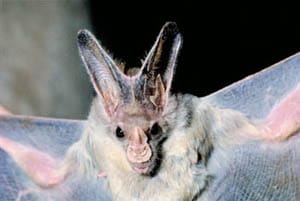The Greater Ghost Bat is a large and very territorial bat species that mainly inhabits rainforests across South East Asia. It has a wingspan that can reach up to three feet and weigh almost an ounce. Their large size, coupled with the fact that they are a formidable flier, makes them popular with wildlife photographers. One of the best things about these bats is that they are not only very photogenic but also come with a fascinating story. Let’s take a closer look.

The Greater Ghost Bat was discovered by Hernandez-Camacho in 1955. It inhabits Brazil, Venezuela, Southeast Colombia, and Guyana. It is currently (2003) listed as a vulnerable species. This particular species also inhabit Peru.
Very few reportings of this particular bat species have been uncovered. It is from the Diclidurus family of bats.
Brazil has 138 identified bat species, however, very little research has been carried out on some of the species. This particular species is one of those, as it is rare to find this particular species of bat.
A Tale Of Two Brothers
Table of Contents
The Greater Ghost Bat’s scientific name, Mystacalis albicollis, literally means white-collared bat. This aptly describes the species because of the pattern that runs down the center of their neck. It is a common myth that the pattern appears when the wings are spread which is not the case; the pattern is actually present all the time. In fact, this is one place where this species’ pattern takes on a truly magical appearance, making it stand out even among other mammals of its size and proportions. The dark spots on the back are part of a symmetrical pattern as well.
A Family Affair
The Greater Ghost Bat’s appearance changes depending on whether it is breeding or hunting season. In the first case, its fur is almost entirely white with large black spots on its back. During the breeding season, the spots on its neck and back are more apparent, and there are more white hairs around its face.
When hunting, the species becomes a bit more streamlined, shedding a lot of its excess weight. The tail is also significantly reduced and flattened. These are all helpful traits that enhance their agility as well as their ability to snatch small animals and insects in mid-flight. This makes the Greater Ghost Bat a frequent victim of bird and insect-eating predators like snakes, birds of prey, and frogs. They are also known to raid crops, so this makes them an important pest in the area where they live.
A Parent’s Instinct
When it comes to parenting, the Greater Ghost Bat does its best to protect its young from harm. Its parental instinct is so strong that it will even go to extreme lengths to ensure the survival of its offspring. One of the best instances of this is the behavior it exhibits toward snakes. Since snakes are known to be among the species it encounters on the food chain, it will attack them on sight. They will even bite through the body of a large snake to protect their baby from being eaten. This is one of the reasons why it is a good idea to avoid getting too close to wildlife, especially when they are pregnant or have young ones at home.
Being a top predator, the Greater Ghost Bat influences the food chain it inhabits. Its natural enemies are therefore in part responsible for maintaining a healthy balance of nature in its vicinity. However, humans’ unsanitary practices and the overhunting of smaller animals for sport also contribute to the decline of this species. The greater the number of individuals, the greater the chance of survival for the species as a whole. Habitat loss due to deforestation is also a major threat to the Greater Ghost Bat. Without the protection of their natural environment, the species will struggle to make a comeback. Fortunately, there are still relatively large swaths of rainforest left in Southeast Asia which provide the greater part of these bats with their living space. It is hoped that in the future the species will be able to repopulate and restore the habitats they need to survive. In the meantime, it is important to appreciate these animals for what they are; gigantic and majestic creatures, whose habits and behavior are as intriguing as they are photogenic. This is certainly not the case with all large wildlife, so let’s not let this get out of hand.
